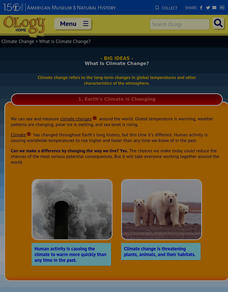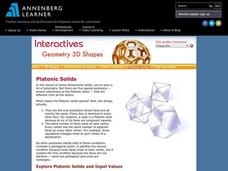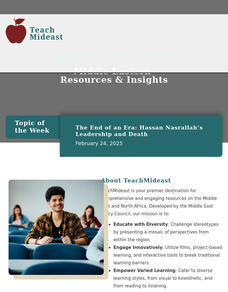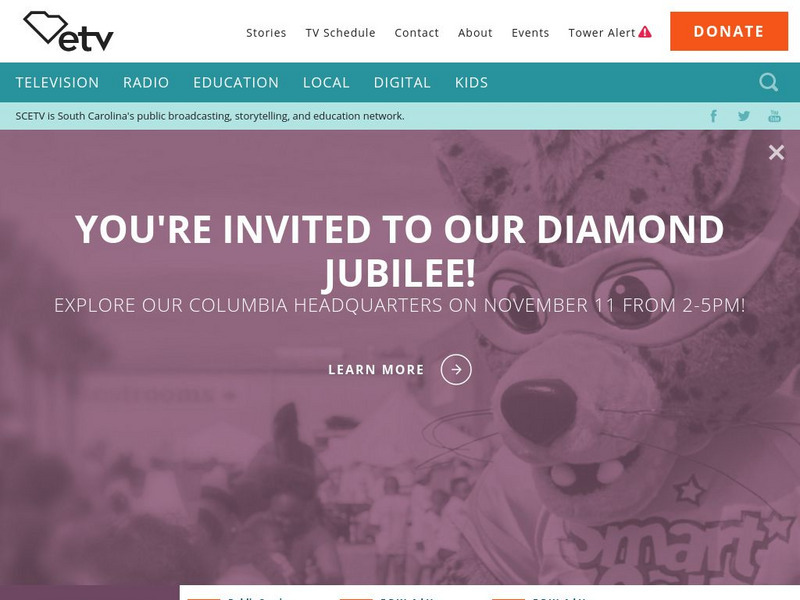American Museum of Natural History
What is the Greenhouse Effect?
Without the greenhouse effect, Earth would not be inhabitable. A thorough online resource describes the greenhouse effect and how it occurs. The source highlights the different types of gases that work together to absorb the sun's...
Annenberg Foundation
Geometry 3D Shapes: Euler's Theorem
How do you get a theorem named after you? Euler knows what it takes! The third lesson of five asks pupils to use an interactive activity to compare the faces, vertices, and edges of seven different three-dimensional solids. They use...
American Museum of Natural History
What is Astronomy?
Go study the universe. Pupils learn seven aspects about astronomy and astronomers. They begin to learn about constellations; distance and motion between objects; gravity; the electromagnetic spectrum; dark matter and energy; and teams of...
American Museum of Natural History
What Is Climate Change?
So many factors show that climate change has arrived. Learners read through an online resource that explains the data and the consequences of climate change. They also review strategies for slowing or even reversing the global influence.
American Museum of Natural History
Paleontology Books
A list of 11 books about paleontology offers titles, authors, and a brief description of the tale.
Annenberg Foundation
Geometry 3D Shapes: Platonic Solids
From polyhedrons to platonic solids, here is a lesson that will have your classes talking! As an introduction to platonic solids, scholars cut and fold nets to create the three-dimensional solids. They use an interactive component to...
American Museum of Natural History
A Closer Look at Mars
A website looks at how we know so much about Mars—telescopes, robots, and spacecraft—and the search for martian life. Following the informational text are three questions that quiz pupils about possible life on Mars.
American Museum of Natural History
Saving Species
Some scientists dedicate their lives to researching and protecting endangered species. An online lesson teaches about three scientists around the world who do just that. They learn about spiders, mollusks, and reptiles from North...
abcteach
Abcteach: Earth Day Activities
[Free Registration/Login Required] How can you treat the earth with more respect? Check out this resource featuring links to elementary activities to celebrate Earth Day. You will find word searches, crossword puzzles, reading...
Planet Pals
Planet Pals: Earth Day
This PlanetPals.com site provides the "Greatest Earth Day Pages Ever!" Includes activities, teaching aides, earth science and history, and more.
Other
K 3 Learning pages.com: Earth Day Links
How can you celebrate Earth Day in your classroom? This collection features several downloadable Earth Day worksheets including word searches and coloring pages. Students and teachers can plan the perfect way to recognize the environment.
Other
Envirolink: Earth Day
A concise site that gives the students the opportunity to learn all about how Earth Day was started.
US Geological Survey
Usgs: Geologic Provinces of the United States: Records of an Active Earth
Discover what geological treasures abound all around the nation. The United States has been organized into provinces based on geological features. Click on a province on the map, or on the links below it, to view a page of information...
Treehut
Suzy's World: Life on Earth
This site from Suzy's World, which is a personal site from Suzy Cato, explores what evolution is, and how long there has been life on earth. Content includes fun facts, a great experiment, and a classroom activity.
US Geological Survey
Usgs: Earth Surface Dynamics (Research Activities)
This site from USGS provides several activities to help understand the interrelationships among earth surface processes, ecological systems, and human activities. Also included are links to new findings and programs concerning Earth...
Nebraska Studies
Nebraska Studies
A large site that tracks the history of the Nebraska area begins with the formation of the earth, moves through the earliest human activity in Nebraska, and then through proto-historical and historical Nebraska. The Kansas-Nebraska Act,...
Smithsonian Institution
Smithsonian Institution: Time and Navigation
Explore navigation methods by sea, air, and space, what latitude and longitude mean, how GPS works, about satellite navigation, and learn about professional navigators. Includes a timeline of developments in navigation from 1280 to the...
United Nations
United Nations: World Environment Day
Every year on June 5th, people around the world celebrate World Environment Day. Learn about the history of this eco-conscious event and how you can share with others the activities you participate in for this important day.
Other
Sacnas: The Biography Project
This site profiles dozens of Chicano/Latino and Native American scientists. Most are still active in their field of research. Searchable by field of science. Also contains links to some fantastic science sites by topic.
Middle East Policy Council
Middle East Policy Council: Teach Mideast
TeachMideast, a comprehensive instructional portal home to a variety of resources on the Middle East and Islam, considers this region of the world from seven thematic perspectives: stereotypes, geography, history, language, religion,...
Other
South Carolina Educational Television (Scetv)
Visit the "Education" site of SCETV and find resources for the classroom. The site provides videos, written guides, and learning activities to accompany many of the network's programs: e.g., "Circle of Inheritance," (a history of South...

















